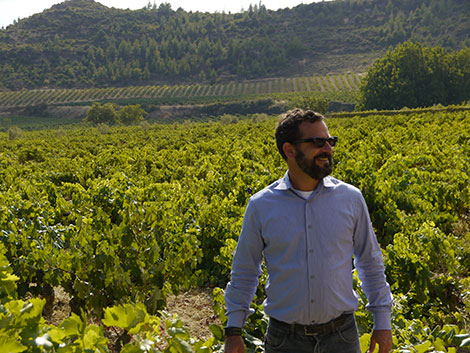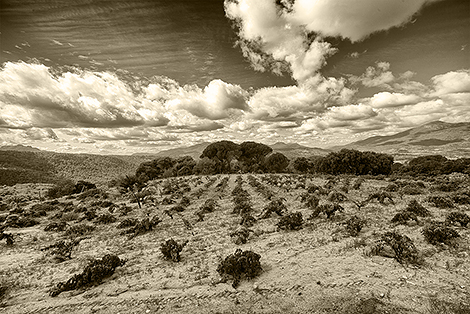Sherry 101: An introduction to styles and pairings
Despite their fame, history and quality, wines from the Sherry Triangle are widely unknown among the general public as well as among aficionados and people in the wine trade.
A combination of clever marketing campaigns, the efforts of new and well-known producers, trade professionals in search of a change and the enthusiasm of part of the specialist press have helped to spread the message about the quality of sherry wines but, for the time being, that passion has not meant an increase in sales or prices.
Many Spaniards still think of sherry as an ingredient of rebujito (a mix of sherry and lemonade) which is drunk on beach bars and summer fiestas. Outside of Spain, a sherry copita is a sweet drink that grannies and Downton Abbey characters used to sip but the diversity of styles is overwhelming, beyond Pedro Ximénez and Cream which are likely to be Lord Crawley’s favourites. The truth is that blended wines like Cream (a mix of PX and Oloroso commonly known as Sweet Oloroso) represent half of the total sales figures, according to Sherry’s Regulatory Body. Amontillados, Olorosos and Palos Cortados barely represent 3% of the overall sales.
And yet Sherry wines are truly unique; the diversity of styles, from the driest to the sweetest, is unmatched by any other wine in the world as well as their capacity to pair with all kinds of dishes. Sherry wines definitely deserve to be better known.
On the eve of Sherry Wine Week with hundreds of events across the world between 2-8 November, we pay homage to this great wine with a basic guide to the styles, production and pairings to make them the guest stars at foodies’ tables across the world.
Viticulture:
6,838 hectares under vine in nine towns: Jerez de la Frontera, El Puerto de Santa María, Sanlúcar de Barrameda, Lebrija, Trebujena, Chipiona, Rota and Puerto Real. According to data collected by the DO Sherry, 80% of the vineyards are mechanically harvested.
Aging wineries can only be located in three historic towns in the appellation: Jerez, El Puerto and Sanlúcar (Jerez Superior). The other towns belong to what is known as the Zona.
300 sunny days per year with mild winters and hot summers and an average rainfall of 620 l/m2 (In Rioja Alavesa that figure stands at 500l/m2) and two dominant winds: Levante (warm and dry) and Poniente (fresh and humid) which create a set of climate conditions which are rather unique and necessary for the layer of yeast (flor) to develop.
Allowed varieties:
Palomino (95% of the total surface under vine), Moscatel and Pedro Ximénez. Outside of the DO, some producers are trying to recover varieties which used to be common in sherry wines such as Mantúo de Pilas, Mantúo Castellano, Perruno, Cañocazo and Beba but which phylloxera and the dominance of Palomino Fino left behind.
Soils:
Sought-after Albariza (white soil with a high content of calcium carbonate which retains humidity); barros or clays, which are fertile and located on the valleys and arenas or sands, which are found on coastal areas and are suitable for Moscatel.
Wine types and production methods:
Dry Sherries: Known as Generoso wines, they are dry and have a maximum residual sugar quantity of 5g/l. Fino, Manzanilla, Amontillado, Oloroso and Palo Cortado are included in this category.
Naturally Sweet: rich in sugar. Moscatel and Pedro Ximénez
Generoso Liquor Wines: dry wines with added sweetness (locally known as cabeceo). Pale Dry, Pale Cream, Medium and Cream are within this category.
Once fermented, wines are tasted and classified according to their characteristics. Pale, clean musts are set to become Fino and Manzanilla, while wines with structure are classified as Oloroso. Although it is not compulsory by the Regulatory Body, these young wines —which are called mostos (musts) in the region— are usually fortified with alcohol to increase their strength based on the type of aging they will follow.
Once classified, wines are aged in used oak casks in criaderas and soleras, a system of scales whereby younger wines are used to refresh older ones in order to obtain a uniform style of wine.
Fino and Manzanilla from Sanlúcar:
They are dry wines made from Palomino grapes and fortified to 15% vol. During their aging in casks they develop a fine layer of yeast on the surface known as flor. Yeast protects wine from the air and prevents oxidation. The resulting wines are pungent, delicate and bitter on the palate.
There are two traditional types: manzanilla fina is bottled at 3-5 years of age (the minimum by law is two years) and manzanilla pasada, more complex and with dying flor (6-8 years or more). En rama means that the wines have seen a minimal amount of clarification or filtration.
There are some vintage finos and manzanillas, which are not refreshed with young wines, such as Fino Vintage 2006 by Williams & Humbert or manzanilla 2012 1/11 by La Callejuela, whose winemaker is maverick Ramiro Ibáñez. These rarities are actively sought-after by enthusiasts.
Food matching: Manzanillas and finos are excellent aperitifs to drink with tapas or Iberico ham, specially in the bars and taverns of Jerez, Sanlúcar and El Puerto, but they also pair fabulously well with Japanese or Galician seafood dishes and are a basic ingredient in the renewed cocktail fashion in New York and San Francisco. Antonio Barbadillo goes beyond these pairings and recommends his Sacristía AB manzanilla, with 8-10 years under flor, with rice pudding.
Amontillado:
Finos or manzanillas partially aged under a layer of yeast or flor (3-8 years). When yeasts die, either naturally or due to the addition of alcohol, these wines continue their oxidative aging without flor. Amber in color and with pungent aromas, these dry wines have a lingering aftertaste with hints of nuts and wood and al alcoholic strength of 16 to 22%.
Food matching: They are the perfect accompaniment for difficult to pair products such as artichokes or asparragus and pair very well with a good bluefin tuna cut such as those served at El Campero restaurant in Barbate or a Mexican mole sauce over pork or roasted chicken.
Oloroso:
Alcohol is added to 17%, thus preventing the development of the veil of flor and allowing the wine to age while exposed to oxygen. Ranging from rich amber to deep mahogany in colour, it is dry and with a predominantly nutty and round bouquet (toast, coffee) and lingers in the mouth. Once bottled it reaches 17-22% alcohol.
Food matching: It’s widely accepted that Olorosos pair well with meat stews such as oxtail or simmered pieces of beef cheek but Armando Guerra, owner of la Taberna der Guerrita in Sanlúcar, enjoys it with a free-range roasted chicken seasoned with “a pinch of nutmeg”.
Palo Cortado:
Ranging in color from amber to mahogany, these wines combine the pungent nose of an Amontillado with the structure and body of an Oloroso, but the DO does not set any rules in terms of vinification methods. There is a halo of mystery around these wines, which undoubtedly helps their marketing; it is said that they occur spontaneously, when a fino loses the layer of yeast. Once fortified and aged oxidatively, it turns into a Palo Cortado combining finesse and body.
Food matching: Classic pairings for Palo Cortado are foie gras, cured cheeses and mushrooms, but Pepe Ferrer, Sherry’s official gastronomic ambassador, suggests an Indian dish of meat curry.
Pedro Ximénez:
These sweet wines are made from very ripe Pedro Ximénez grapes which are dried in the sun to obtain a must with an exceptionally high concentration of sugar. Most PX grapes come from Montilla-Moriles, but there are still a few pagos left in Jerez where this grape is cultivated. Wines are dark mahogany or ebony in color with intense and sweet raisin aromas and a dense texture. The oldest examples (30 years or more) have more acidity and display smoke aromas but without losing their sweetness.
Food matching: The most traditional pairings are with bitter chocolate, blue cheeses or ice-creams but Sanlúcar winemaker Ramiro Ibáñez suggests his PX Pandorga from pago Carrascal in Sanlúcar with spicy Mexican dishes.
Cream:
A semi sweet wine which is obtained exclusively from oxidative ageing and involves blending Oloroso with Pedro Ximénez. Brown to dark mahogany in colour, this wine combines a syrupy appearance with typical Oloroso aromas and a hint of sweetness reminiscent of nougat or caramel.
Food matching: It is the ideal dessert wine and pairs well with fruit (melon, orange) pastries or ice-cream, but Pepe Ferrer suggests an original alternative: stewed venison with dried peaches and apple.
The dimension of time is important in sherries, which have a certification system for old wines known as VOS (average age of at least 20 years) and VORS (30 years). These wines display an astonishing quality at very affordable prices given that they belong to the world’s wine elite.
Other appellations with more standard products and less tradition have managed to take advantage of their brands but there is a glimpse of change. Until that day arrives, Sherry will still be the world of wine’s best kept secret.

Yolanda Ortiz de Arri
A journalist with over 25 years' experience in national and international media. WSET3, wine educator and translator
NEWSLETTER
Join our community of Spanish wine lovers






